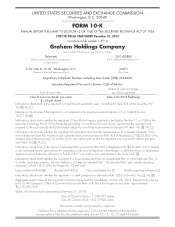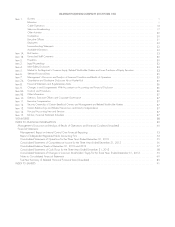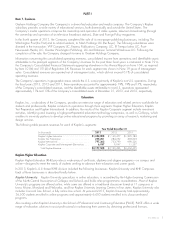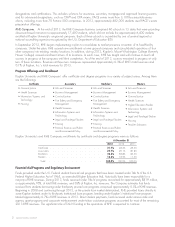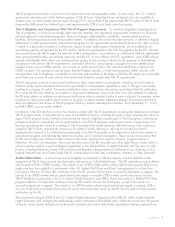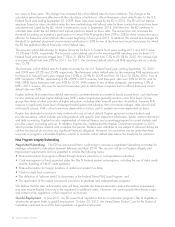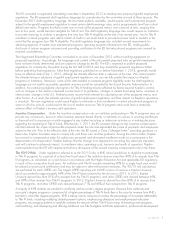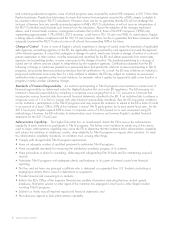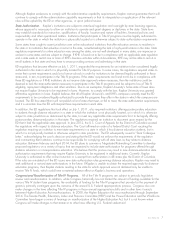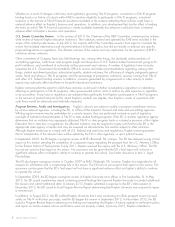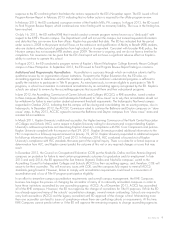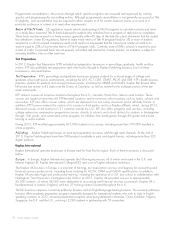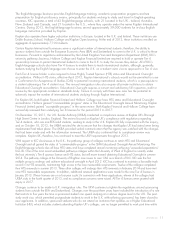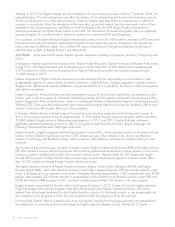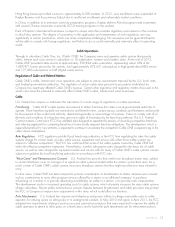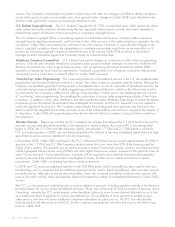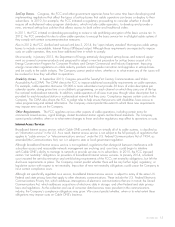Washington Post 2013 Annual Report Download - page 23
Download and view the complete annual report
Please find page 23 of the 2013 Washington Post annual report below. You can navigate through the pages in the report by either clicking on the pages listed below, or by using the keyword search tool below to find specific information within the annual report.The ED convened a negotiated rulemaking committee in September 2013 to develop new proposed gainful employment
regulations. The ED prepared draft regulatory language for consideration by the committee at each of three sessions. The
December 2013 draft regulatory language, the last made publicly available, would require each educational program
subject to the gainful employment regulation to meet certain debt-to-earnings ratios and a programmatic level loan cohort
default rate metric. Programs that fail to meet one or more of the proposed metrics over a period of time, ranging from
two to four years, would become ineligible for Title IV aid. The draft regulatory language also would require an institution
to provide warnings to students in programs that may lose Title IV eligibility at the end of an award year, limit its Title IV
enrollment in these programs and submit a letter of credit or set aside funds to provide borrower relief to students in the
event that the programs lose Title IV eligibility. The draft regulatory language also included revised requirements for
obtaining approval of certain new educational programs, reporting program information to the ED, making public
disclosure of certain program outcomes and providing certification to the ED that educational programs are covered by
required accreditations.
The Negotiated Rulemaking Committee concluded its sessions in December 2013 without reaching agreement on
proposed regulations. Accordingly, the language and content of the anticipated proposed rules on gainful employment
have not been finally determined and are subject to change by the ED. The ED is expected to publish proposed
regulations for comment by the public during the first half of 2014 and may amend the proposed regulations further
before publishing final regulations. New final regulations published on or before November 1, 2014, generally would
have an effective date of July 1, 2015, although the ultimate effective date is unknown at this time. We cannot predict
the ultimate timing or substance of gainful employment regulations, nor can we fully predict the impact on Kaplan
programs or institutions. Moreover, some of the data needed to compute program eligibility under the draft regulatory
language are not readily accessible; graduate incomes would be compiled by the Social Security Administration. In
addition, the continuing eligibility of programs for Title IV funding may be affected by factors beyond Kaplan’s control,
such as changes in the actual or deemed income level of its graduates, changes in student borrowing levels, increases in
interest rates, changes in the U.S. Federal poverty income level relevant for calculating one of the proposed metrics and
other factors. As a result, the ultimate outcome of gainful employment regulations and their impact on Kaplan’s operations
is uncertain. The new regulations could cause Kaplan to eliminate or limit enrollments in certain educational programs at
some or all of its schools, could result in the loss of student access to Title IV programs and could have a materially
adverse effect on Kaplan’s business and operations.
Incentive Compensation. Under the incentive compensation rule, an institution participating in Title IV programs may not
provide any commission, bonus or other incentive payment based directly or indirectly on success in securing enrollments
or financial aid to any person or entity engaged in any student recruiting or admission activities or in making decisions
regarding the awarding of Title IV funds. Effective July 1, 2011, the ED enacted changes to the incentive compensation
rule that reduced the scope of permissible payments under the rule and expanded the scope of payments and employees
subject to the rule. Prior to the effective date of the rule, the ED issued a “Dear Colleague Letter,” providing guidance on
these rules. Kaplan has taken steps to comply fully with these rules and the guidance. Among the actions taken, Kaplan
has revised its compensation plans for admissions personnel and eliminated enrollment results as a component in the
determination of compensation. Kaplan believes that this change in its approach to recruiting has adversely impacted,
and will continue to adversely impact, its enrollment rates, operating costs, business and results of operation. Kaplan
cannot predict how the ED will interpret and enforce all aspects of the revised incentive compensation rule in the future.
The 90/10 Rule. Under regulations referred to as the 90/10 rule, a KHE school would lose its eligibility to participate
in Title IV programs for a period of at least two fiscal years if the institution derives more than 90% of its receipts from Title
IV programs, as calculated on a cash basis in accordance with the Higher Education Act and applicable ED regulations,
in each of two consecutive fiscal years. An institution with Title IV receipts exceeding 90% for a single fiscal year would
be placed on provisional certification and may be subject to other enforcement measures. The 90/10 rule calculations
are performed for each OPEID unit. The largest OPEID reporting unit in KHE in terms of revenue is Kaplan University,
which accounted for approximately 69% of the Title IV funds received by the division in 2013. In 2013, Kaplan
University derived less than 81% of its receipts from the Title IV programs, and other OPEID units derived between 69%
and 89% of their receipts from Title IV programs. In 2012, Kaplan University derived less than 80% of its receipts from
Title IV programs, and other OPEID units derived between 71% and 88% of their receipts from Title IV programs.
A majority of KHE students are enrolled in certificate and associate’s degree programs. Revenue from certificate and
associate’s degree programs is composed of a higher percentage of Title IV funds than is the case for revenue from KHE’s
bachelor’s and other degree programs. KHE is taking various measures to reduce the percentage of its receipts attributable
to Title IV funds, including modifying student payment options; emphasizing direct-pay and employer-paid education
programs; encouraging students to carefully evaluate the amount of their Title IV borrowing; eliminating some programs;
cash-matching; and developing and offering additional non-Title IV-eligible certificate preparation, professional development
2013 FORM 10-K 5




